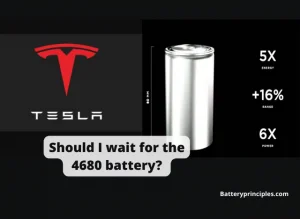It is most likely due to the battery not providing enough power to the starter motor. This condition can also cause by several issues: a dead battery, a faulty starter motor, a bad alternator, corroded battery terminals, or electrical problems. To determine the exact cause of this, you may need to do some troubleshooting or take your car to a mechanic for diagnosis and repair.
In this article, we will find out in detail the reasons why your car battery may read 12.5 volts but still won’t start. And discover possible solutions to help get your vehicle moving again and the importance of regular maintenance to prevent this problem from occurring in the future.
Possible reasons – Car battery reads 12.5 volts but won’t start
1. The battery charge is insufficient.
If your car battery reads 12.5 volts but won’t start, it’s because it’s probably not charged enough. To check, use a voltmeter to measure the voltage while the engine is running. If there is no voltage of nearly 12.5 volts, the battery is not charged sufficiently.
Then it should charge with an external charger or something else. It is essential to use the appropriate charge type and settings.
2. The battery is Dead
The second most common reason is that the battery is dead. A battery may show 12.5 volts, but not enough amps to start the car. Then the voltage can drop significantly during load. So, it needs to be charged or replaced.
3. The alternator is malfunctioning.

Have you ever been stuck in a situation where the battery has 12.5 voltage, but won’t start? If so, you’re probably dealing with a problem with the alternator. The alternator is an essential component that charges the battery, and if it is not working well, your car will not start.
A malfunctioning alternator includes dimming or flickering dashboard lights or the battery warning light illuminating the dashboard.
The first step in troubleshooting an alternator is to test it. To do this, use a multimeter to measure the voltage output of the alternator. If the reading is less than 12.5 volts, you know the alternator is not working, and if it is around 12.5 volts, the alternator is working, and the problem may lie elsewhere.
4. The starter motor failure.
The starter is one of the most substantial parts of a car. It starts the combustion cycle by connecting the flywheel and crankshaft to the engine.
Symptoms of a faulty starter motor include a clicking sound when you turn the key or the engine starting slowly or not at all.
To test a starter, you will need to use a voltmeter and connect the positive terminal of the voltmeter to the positive terminal of the starter, and the negative terminal of the voltmeter to the starter’s negative terminal. If the voltage reads 12.5 or a similer voltage, the starter is working correctly, and the voltage is less than 12.5 volts, the starter needs to replace.
5. Internal Electrical system problems
An electrical system problem can also prevent the car from starting. It could be due to a faulty ignition switch, damaged wiring, or blown fuse. Car electrical problems are often complicated, so it’s wise to take your car to a service station for diagnosis and repair.
6. Battery connection problem
A battery connection problem can also cause a car won’t start. Make sure, the wires are correctly and securely connected to the battery terminals and are no signs of corrosion, wear, tear, or other damage.
If the connections are loose, it can cause poor starting currents. In addition, it can build up heat, causing further damage to the battery and electrical system of the car.
7. The blown fuse
The role of a fuse in a car is to protect the electrical system from any accident. When a car battery reads 12.5 volts but won’t start, the next thing to check is the car fuse.
Checking the fuse is a simple process.
Once you locate the fuse box, find the correct one by checking the manual or diagram inside the cover. A multimeter can then use to test it. Touch it to each fuse, it shows 12 volts or more when the fuse is working and zero volts when blown and can also perform this test with a fuse testing tool (you can purchase it from an automobile spare parts store) instead of using a multimeter.
8. Battery Corrosion
Corrosion in car batteries can also be very confusing. A corroded battery may show 12.5 volts, but the car won’t start. Dirt, grime, and moisture build-up on the battery terminals can cause corrosion and prevent the battery from supplying enough power to the starter and other electrical components.
To detect and repair corrosion, inspect the battery terminals for dirt or grime build-up. If there are, use a wire brush to remove them, then apply corrosion inhibitor spray to the terminals.
Once it is over, check the battery voltage with a multimeter to ensure it is still around 12.5 volts. If not, the battery may need to replace.
9. Compression problems
Even if a car battery shows 12.5 volts, it won’t start when the engine has compression problems. Compression is an essential part of how an engine works, as it is responsible for drawing air and fuel into the cylinders, compressing it to create a spark, and then releasing the exhaust. As such, compression problems can lead to poor fuel economy and reduced power.
To diagnose compression problems, use a compression tester to measure the amount of compression occurring in the engine. If compression is low, you will need to investigate further to determine the root cause of the problem, such as piston rings, leaking head gaskets, or worn valves. After identifying it, you can decide the best way to repair it, such as replacing the damaged parts or rebuilding the engine.
Is your battery terminal melted? Here is an easy way to fix It
Battery principles
Car battery maintenance tips to extend battery life
A car’s battery provides the energy it needs to start the engine and run the electronics, so proper attention should be paid to its maintenance.
- Keep the car engine clean.
The first thing to do to keep our battery in good condition is to keep the engine clean and at the same keep the battery clean because dirt, dust, and oil badly affect all the components of our vehicle.
Batteries have small vents to release some gases, dust can cover them and this affects their performance. It is recommended to clean the dust or dirt from the battery.
2. Check the electrolyte level.
Checking a battery’s electrolyte level is essential for battery care and maintenance. It is necessary to check the electrolyte level of each cell and add distilled water if the electrolyte level is below the acceptable mark. However, do not overfill the battery as this may damage it.
3. Check the condition of the battery case.
The case also makes a significant contribution to battery life, so its condition should be checked regularly. If you find corrosion or other damage in the case, you should take steps to remove them to avoid premature battery failure. A mixture of water and sodium hydroxide can use to remove corrosion, and silicone spray can use to prevent corrosion.
4. Check corrosion on the terminals.
Corrosion can build up on battery terminals, causing poor connections and also causing battery performance to decrease. Check the battery terminals for corrosion and clean them with a steel brush or abrasive paper, and ensure that the terminals are firmly pressed against the contacts and do not move.
5. Use the vehicle continually.
Another frequent question is, can the battery be weak by stopping it for a long time (months or, a year)?
Yes, Because the battery works through a chemical reaction and needs charging to maintain the dynamics of consumption and energy. So, it should charge by using the car.
If you have to leave the vehicle without using it for a long time, it is better to use a battery charger to keep it charged. It helps prevent draining and decreasing battery life.
6. Avoid overcharging
Overcharging the battery can cause it to quickly degrade and reduce performance. Avoid idling vehicles for long periods and overloading electronics that consume battery power.
7. Check battery life
The life of a car battery is usually 3 to 5 years, but it can be shortened or extended depending on the conditions of use. If you see signs that the battery is starting to deteriorate, it is worth replacing it to prevent further problems.
How many watts in a 12-volt battery – Unlocking the Mystery of 12v Battery Capacity
battery principles
Conclusion

For multiple reasons, your car may not start even if its battery shows 12.5 volts, such as low battery charge, dead battery, faulty starter motor and alternator, corroded battery terminals, or electrical problems. Identifying these reasons will help you troubleshoot the issue and get your car back on the road. However, are you don’t have the proficiency or experience to diagnose and repair the problem, it’s best to show your car to a mechanic or take it to a service station for professional assistance.
And after you solve this issue, you should pay proper attention to battery maintenance. Then you won’t have to face the additional cost of replacing your battery or other vehicle malfunctions.






